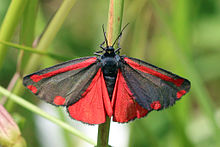Cinnabar moth
| Cinnabar moth | |
|---|---|
 |
|
 |
|
| Both at Piddington Wood, Oxfordshire | |
| Scientific classification | |
| Kingdom: | Animalia |
| Phylum: | Arthropoda |
| Class: | Insecta |
| Order: | Lepidoptera |
| Family: | Erebidae |
| Genus: | Tyria |
| Species: | T. jacobaeae |
| Binomial name | |
|
Tyria jacobaeae (Linnaeus, 1758) |
|
| Synonyms | |
|
|
The cinnabar moth (Tyria jacobaeae) is a brightly coloured arctiid moth, found in Europe and western and central Asia. It has been introduced into New Zealand, Australia and North America to control poisonous ragwort, on which its larvae feed. The moth is named after the red mineral cinnabar because of the red patches on its predominantly black wings. Cinnabar moths are about 20mm long and have a wingspan of 32–42 mm (1.3–1.7 in).
Cinnabar moths can be found throughout Britain, except northern Scotland, wherever its larval foodplant, ragwort and groundsel, are present.
This species is so named due to the colour of the hindwings and the markings on the forewings which make it unmistakable. There is little variation although on rare occasions the pinkish markings are replaced with yellow, or the forewing is red with a black border or the wings are completely black. Easily disturbed by day and flies in sunshine. Also flies after dark. Cinnabar moths are day-flying insects. Like many other brightly coloured moths, it is unpalatable; the larvae use members of the genus Senecio as foodplants. Many members of the genus have been recorded as foodplants, but for long-term population success, the presence of the larger species such as ragwort is needed. Smaller plant species, such as groundsel, are sometimes used, but since the species lays its eggs in large batches, survival tends to be reduced. Newly hatched larvae feed from the underneath of ragwort leaves within the area of their old eggs. The larvae absorb toxic and bitter tasting alkaloid substances from the foodplants, and assimilate them, becoming unpalatable themselves. The bright colours of both the larvae and the moths act as warning signs, so they are seldom eaten by predators. An exception is among different species of Cuckoo which eat hairy and poisonous caterpillars including cinnabar moth larvae.
...
Wikipedia
